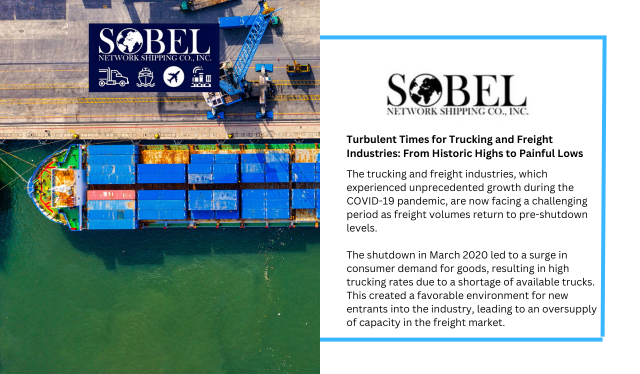The trucking and freight industries, which experienced unprecedented growth during the COVID-19 pandemic, are now facing a challenging period as freight volumes return to pre-shutdown levels.
According to Craig Fuller, president and CEO of FreightWaves, a supply chain media company, the current market conditions are worse than the financial crisis of 2007-08. Fuller predicts that the worst is yet to come, as the number of trucking fleets in the United States surged from 209,000 to 318,000 between January 2019 and May 2023. This rapid expansion was fueled by excessive spending, with $6 trillion in government funds intended to alleviate the crisis caused by the pandemic.
The shutdown in March 2020 led to a surge in consumer demand for goods, resulting in high trucking rates due to a shortage of available trucks. This created a favorable environment for new entrants into the industry, leading to an oversupply of capacity in the freight market.
However, as the saying goes, what goes up must come down. The problem now is that freight volumes have returned to 2019 levels, while the number of trucks competing for the same freight has significantly increased. Fuller anticipates that every company in the industry will face similar challenges and will need to downsize and reduce costs to survive. He expects this downturn to persist for 18 to 24 months, resulting in numerous bankruptcies. Eventually, when the economy recovers, the market will face a shortage of capacity.
Thom Albrecht, CFO and CRO of Reliance Partners, an insurance agency serving the transportation and logistics sectors, explains that the industry got caught up in the belief that the pandemic-induced boom was the “new normal.” However, it was merely a temporary phase caused by the unique circumstances. Albrecht identifies three phases in this cycle: the initial surge in goods demand, followed by a shift from goods to services, and finally, a decline in consumer spending.
Wages have been trailing inflation since 2021, and consumers’ buying power has decreased as credit card debt soars to a 20-year high and savings dwindle to around 2%. Retailers’ inventory imbalances, such as Target’s surplus of home electronics and shortage of travel-related products, indicate consumer strain.
Despite the challenges, Albrecht sees some signs of the market stabilizing. Inbound loading containers at the top 10 U.S. ports have shown a slight sequential rise for the first time since summer 2021. Although this is a small indication, it suggests that the industry may have reached the bottom of the slump.
Albrecht believes that the trucking industry will begin to normalize by Labor Day, with a potential recovery by spring 2024, even if the broader economy remains in a recession.
The transportation industry plays a vital role in the city of Chattanooga, with its extensive rail and water transportation networks and central location. Therefore, when the transportation industry faces challenges, it affects many people in the area.
Frank Butler, a professor at the University of Tennessee at Chattanooga, explains that the current slowdown in the industry is influenced by multiple factors, including rising interest rates, reduced consumer spending, and companies clearing out excess inventory accumulated during the pandemic. Geopolitical issues such as societal shutdowns in China and conflicts in Ukraine have also disrupted the U.S. supply chain.
Butler emphasizes that trucking and logistics have always been cyclical industries, prone to boom and bust cycles. Companies can mitigate the impact by diversifying into related businesses such as truck leasing services and insurance. Larger companies, especially those publicly traded, have more resources to weather the storm, while smaller companies may struggle, relying on brokerage houses to secure shipments. Cash reserves play a crucial role in helping companies survive until the market resets.
In conclusion, the trucking and freight industries are navigating through a period of turbulence as they transition from historic highs to painful lows. The current oversupply of capacity and reduced consumer spending pose significant challenges. However, there are indications that the market is beginning to stabilize, offering hope for a recovery in the coming years.


